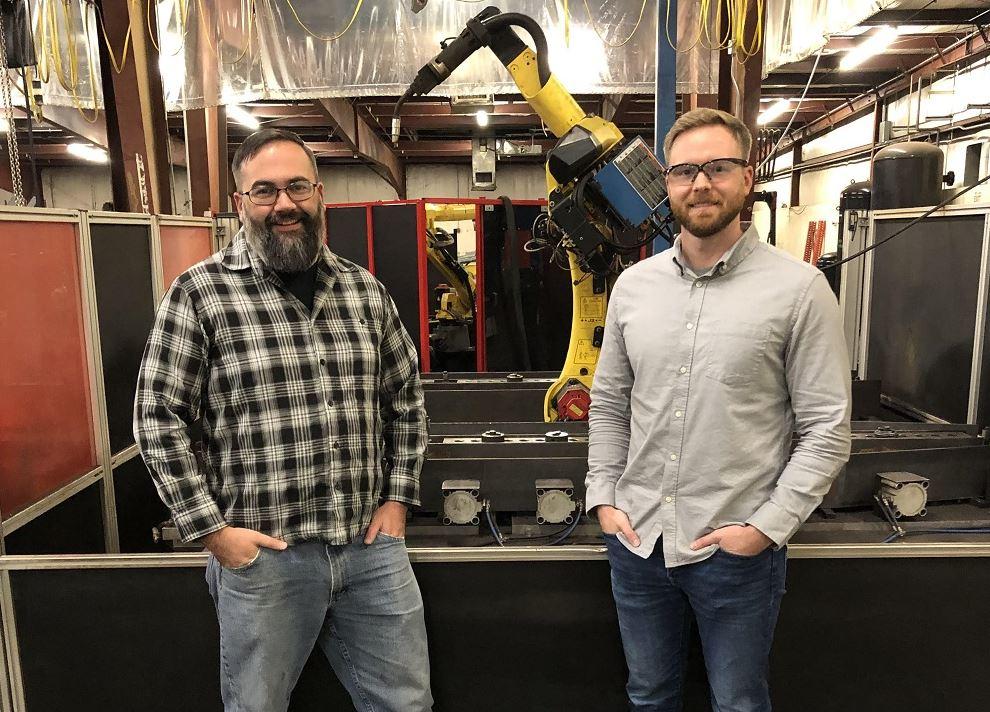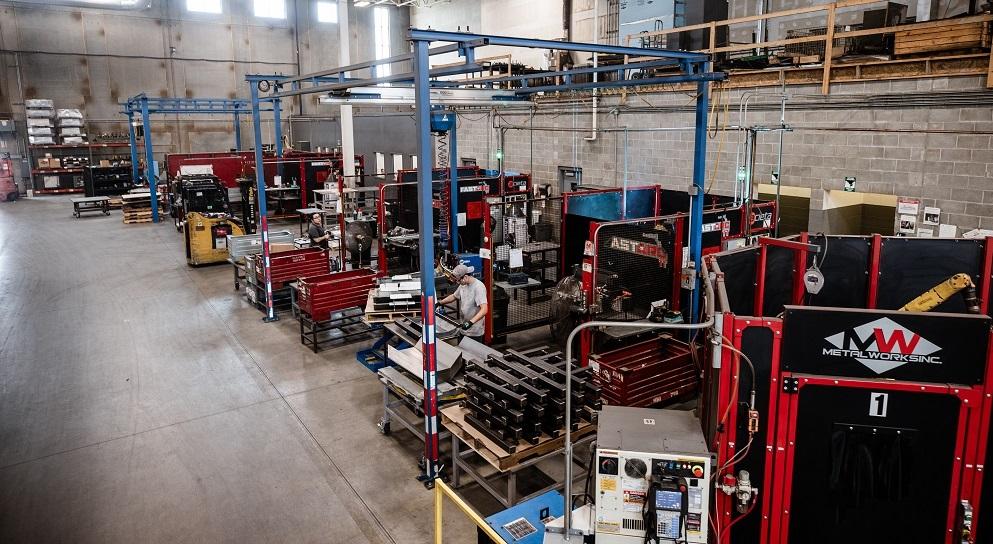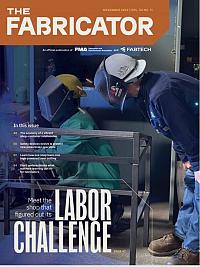Senior Editor
- FMA
- The Fabricator
- FABTECH
- Canadian Metalworking
Categories
- Additive Manufacturing
- Aluminum Welding
- Arc Welding
- Assembly and Joining
- Automation and Robotics
- Bending and Forming
- Consumables
- Cutting and Weld Prep
- Electric Vehicles
- En Español
- Finishing
- Hydroforming
- Laser Cutting
- Laser Welding
- Machining
- Manufacturing Software
- Materials Handling
- Metals/Materials
- Oxyfuel Cutting
- Plasma Cutting
- Power Tools
- Punching and Other Holemaking
- Roll Forming
- Safety
- Sawing
- Shearing
- Shop Management
- Testing and Measuring
- Tube and Pipe Fabrication
- Tube and Pipe Production
- Waterjet Cutting
Industry Directory
Webcasts
Podcasts
FAB 40
Advertise
Subscribe
Account Login
Search
Custom software for the custom metal fabrication shop
Software startup Cortex Data Services has roots in the precision sheet metal business
- By Tim Heston
- November 7, 2023
- Article
- Manufacturing Software

(From left) Brian McMichen and Zach Ernesti took a hard look at Metalworks Inc.’s legacy ERP and, ultimately, decided to start fresh. In 2021, they launched Cortex Data Services.
Zach Ernesti and Brian McMichen know the world of custom metal fabrication. For years they worked at Metalworks Inc., a large, highly automated operation in Lincoln, Neb. They programmed machines, moved into administration, then focused on the fabricator’s data framework and its legacy enterprise resource planning (ERP) platform.
From there, the headaches began—headaches many shops might be familiar with. As Ernesti recalled, “That data framework consistently hindered operations, bloated administration, and to be honest, made us way less lean.”
Many fab shops might relate to this experience. It’s a common dichotomy of modern sheet metal fabrication: Walk the floor, and you might see rows of robots along with sheet cutting and bending automation—yet go to the front office, and someone is working with printouts of Excel documents. People manually view, interpret, and key in data.
Ernesti and McMichen saw this as an opportunity to start fresh. “As we became more familiar with the data, we would try to patch what we could, and try to make things work with what was available,” Ernesti said. “It eventually dawned on us that we could create our own system.”
They went further than that. Not only did they create their own system, they launched a new company, Cortex Data Services, founded on the concept of software customization. Instead of companies changing processes to fit the structure of a particular software platform, Cortex builds software to fit a company’s process, be it at a custom fabricator, another kind of manufacturer, or outside manufacturing altogether. Today, Metalworks Inc. remains a key client for Cortex, but it also has customers in other manufacturing niches and in other industries.
Born out of a custom metal fabricator in 2021, Cortex operates under a seemingly logical principle: No two companies are exactly alike, so their software shouldn’t be exactly alike either.
Streamline Everything
“One common theme among many ERP systems is that they’re really good at having a place for every data point,” Ernesti said. “Still, some [data points] really don’t pertain to the company using the software. It’s all very generically designed, and some options are just clutter, only there to distract.”
Legacy systems require time-consuming data entry and tedious file exporting, and with that comes the inconsistency with any manual, undocumented task. Let’s face it—few view manual data entry as their dream job. Some enter data a certain way and in certain formats, and those formats might change over the years.
“For instance, the system [at Metalworks] goes back to the 1990s,” Ernesti said. “To get data out, you just export a heap of CSV files, and it’s up to the company to format it into usable, actionable reports. And because it’s just a raw CSV file, there’s only so much you can do with it. That’s a severe limitation.”
The seeds of Cortex were planted when Ernesti and McMichen both still worked for Metalworks, and each realized what needed to happen to make the fabricator’s heap of data usable. “We needed to find a way to get the data into a modern SQL database. From that, we were able to write more consistent reports.”

Metalworks Inc., a custom fabricator in Lincoln, Neb., fully embraced automation. Still, many data entry and reporting tasks remained manual, tedious, and error prone. Images: Cortex Data Services
The two built a system around key data points that Metalworks actually used. They did so using a combination of hard coding around a SQL database, then by using a low-code platform to rapidly build applications to interface with the database in specific ways. Adding that low-code “top layer” can be straightforward—with, that is, the right database structure.
“The real value in what we do,” Ernesti said, “is in the database design and tailoring it to the processes a specific company needs, then writing code that manipulates that data in a way that supports those processes.”
Order Releases, Routings, and Sequencing
One key data point, Ernesti explained, helps determine a critical component of Metalworks’ scheduling: when exactly to release an order to the floor. After analyzing the data, the two found some faults in releasing orders simply by due date, whether or not resources to produce those orders were actually ready and available. Releasing orders only by due date also ignored variables like other jobs on the floor and the needs of downstream processes. Some orders should be run back to back, simply because they share a similar setup on a press brake or other machine. That said, just because similar jobs can be run sequentially doesn’t mean they should be. Other factors come into play, including the capacity and availability of downstream processes.
Consider two jobs, one due four days before the other. Years ago, the job with the earlier due date would of course be released first. Armed with data presented in the right way, though, a shop can uncover hidden capacity just by delaying that order release. It has to do with differences in routings and resources. The soon-due job has a simple routing, just cut and bend. These areas have plenty of capacity, so once the job lands in laser cutting, it’s off to the races.
The other job, however, has a complex routing involving welding and some minor assembly. It isn’t due for a while, but because certain resources downstream will be available at only certain times, the shop releases the order first, cuts and forms it, then preps it for welding at just the right time. Only after this order is through does the shop release that simpler order, which is cut, bent, inspected, then quickly sent out the door.
A job’s potential for rerouting plays a role here too. If it can be rerouted through various machines, it might not need to be released to the floor so soon. If a machine goes down or has limited capacity, the job can always find another path through the shop. On the other hand, if a part has, say, a bend length that requires a specific press brake with the right tools and tonnage, releasing that order earlier can make sense, to ensure the job doesn’t miss its slot on that scarce resource (the brake with the long bed).
Cortex helped Metalworks develop a scheduling system that requires a broader perspective. It’s not just how productive a machine or department is anymore. It’s about how much work actually ships during a given period.
“This can be a hard mindset for people to break,” Ernesti said. “If I’m in charge of the press brake department, it feels good to get a lot of work done, but if all that work is just sitting on a shelf waiting for welding, that work [in the brake department] isn’t time well spent. It’s actually better for a machine to sit idle for 30 minutes to process the right job instead of starting right away on the wrong job.”
Actual Versus Estimated Costs
“We store all aspects of a quote when it’s built,” said Ernesti. “This includes the cost of every aspect of the job—the cost of quality and programming, the current cost of material by vendor, the cost of production itself, the overhead, and the material handling. We then continually measure whether an estimate is accurate, which helps us quote in the future. If we’re losing on a part, why? Did we run it completely different than what the initial estimate stated? We then need to requote it.”
None of this is revolutionary, of course. The real payoff is the way the data is aggregated and used for business strategy and improvement. To realize this payoff, the estimate needs to be all-encompassing. Material doesn’t move itself, and that cost can vary depending on quantities, part geometries, and the mix of jobs on the floor. Some jobs need helpers, others don’t, and those specifics affect direct labor costs.
“We map all the steps, the materials we consume, and which stations we’re going to run the job across, at what rate,” Ernesti said. “We include any outside services and incorporate specific quality steps, like checking 10% of parts of a certain lot size.”
Quotes use machine rates derived from machine-specific data. The shop’s quoting database also stores exactly how long it takes for jobs to run across a group of machines. This is what makes rerouting so effective. If a job needs to be rerouted on the fly, the shop can make it happen and be rest assured that the cost range still falls withing acceptable limits per that initial quote.
Freeing Time, Adding Value
The custom software at Metalworks not only helped meet the fabricator’s unique data needs, it also freed people from tedious, nonvalue-adding labor. In one sense, mindless data entry for a technician in the office is just as wasteful as a skilled operator spending hours on a manual task that automation could easily handle.
Consider material price updates on jobs. “The admin time on that used to be huge,” Ernesti said. “We’d have to open up each material and each part and manually run a new price. Now, the system just asks, ‘Do you want to use current material pricing for this estimate?’ With a few clicks, the entire job is updated with the new material price.”
Metalworks custom software platform also streamlined order entry for loading production jobs for the week. Five people used to enter orders manually. Not anymore.
“We now have automated this process,” Ernesti said. “We basically saved 40 hours a week of high-end administration time involving really talented, critical thinkers who were simply reading records and typing them into a system. Now, we’ve freed them to do actual problem-solving, such as analyzing workflow and specific shop processes. A huge part of what we do is just finding things that are tying up valuable employees.”
About the Author

Tim Heston
2135 Point Blvd
Elgin, IL 60123
815-381-1314
Tim Heston, The Fabricator's senior editor, has covered the metal fabrication industry since 1998, starting his career at the American Welding Society's Welding Journal. Since then he has covered the full range of metal fabrication processes, from stamping, bending, and cutting to grinding and polishing. He joined The Fabricator's staff in October 2007.
subscribe now

The Fabricator is North America's leading magazine for the metal forming and fabricating industry. The magazine delivers the news, technical articles, and case histories that enable fabricators to do their jobs more efficiently. The Fabricator has served the industry since 1970.
start your free subscription- Stay connected from anywhere

Easily access valuable industry resources now with full access to the digital edition of The Fabricator.

Easily access valuable industry resources now with full access to the digital edition of The Welder.

Easily access valuable industry resources now with full access to the digital edition of The Tube and Pipe Journal.
- Podcasting
- Podcast:
- The Fabricator Podcast
- Published:
- 04/16/2024
- Running Time:
- 63:29
In this episode of The Fabricator Podcast, Caleb Chamberlain, co-founder and CEO of OSH Cut, discusses his company’s...
- Trending Articles
Tips for creating sheet metal tubes with perforations

Are two heads better than one in fiber laser cutting?

Supporting the metal fabricating industry through FMA

JM Steel triples capacity for solar energy projects at Pennsylvania facility

Omco Solar opens second Alabama manufacturing facility

- Industry Events
16th Annual Safety Conference
- April 30 - May 1, 2024
- Elgin,
Pipe and Tube Conference
- May 21 - 22, 2024
- Omaha, NE
World-Class Roll Forming Workshop
- June 5 - 6, 2024
- Louisville, KY
Advanced Laser Application Workshop
- June 25 - 27, 2024
- Novi, MI


























